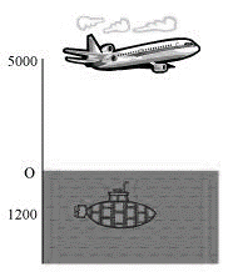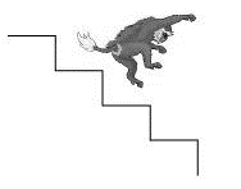
NCERT TEXTBOOK EXERCISES
EXERCISE-1.1
- Following number line shows the temperature in degree Celsius (°C) at different places on a particular day.
 (a) Observe this number line and write the temperature of the places marked on it.
(a) Observe this number line and write the temperature of the places marked on it.
(b) What is the temperature difference between the hottest and the coldest places among the above?
(c) What is the temperature difference between Lahul spiti and Srinagar?
(d) Can we say temperature of Srinagar and Shimla taken together is less than the temperature at Shimla? Is it also less than the temperature at Srinagar? - In a quiz, positive marks are given for correct answers and negative marks are given for incorrect answers. If jack’s scores in five successive rounds were 25, − 5, − 10, 15 and 10, what was his total at the end?
- At Srinagar temperature was − 5°C on Monday and then it dropped by 2°C on Tuesday. What was the temperature of Srinagar on Tuesday? On Wednesday, it rose by 4°C. What was the temperature on this day?
- A plane is flying at the height of 5000 m above the sea level. At a particular point, it is exactly above a submarine floating 1200 m below the sea level. What is the vertical distance between them?

- Mohan deposits Rs 2,000 in his bank account and withdraws Rs 1,642 from it, the next day. If withdrawal of amount from the account is represented by a negative integer, then how will you represent the amount deposited? Find the balance in Mohan’s account after the withdrawal.
- Rita goes 20 km towards east from a point A to the point B. From B, she moves 30 km towards west along the same road. If the distance towards east is represented by a positive integer then, how will you represent the distance travelled towards west? By which integer will you represent her final position from A?
![]()
- In a magic square each row, column and diagonal have the same sum. Check which of the following is a magic square.
| 5 | − 1 | − 4 | 1 | − 10 | 0 | ||
| − 5 | − 2 | 7 | − 4 | − 3 | − 2 | ||
| 0 | 3 | − 3 | − 6 | 4 | − 7 | ||
| (i) | (ii) | ||||||
- Verify a− (−b) = a + b for the following values of a and b.
(i) a = 21, b = 18
(ii) a = 118, b = 125
(iii) a = 75, b = 84
(iv) a = 28, b = 11 - Use the sign of >, < or = in the box to make the statements true.
- A water tank has steps inside it. A monkey is sitting on the topmost step (i.e., the first step). The water level is at the ninth step.
 (i) He jumps 3 steps down and then jumps back 2 steps up. In how many jumps will he reach the water level?
(i) He jumps 3 steps down and then jumps back 2 steps up. In how many jumps will he reach the water level?
(ii) After drinking water, he wants to go back. For this, he jumps 4 steps up and then jumps back 2 steps down in every move. In how many jumps will he reach back the top step?
(iii) If the number of steps moved down is represented by negative integers and the number of steps moved up by positive integers, represent his moves in part (i) and (ii) by completing the following; (a) − 3 + 2 − … = − 8 (b) 4 − 2 + … = 8. In (a) the sum (− 8) represents going down by eight steps. So, what will the sum 8 in (b) represent?
EXERCISE-1.2
- Write down a pair of integers whose:
(a) sum is − 7
(b) difference is − 10
(c) sum is 0 - (a) Write a pair of negative integers whose difference gives 8.
(b) Write a negative integer and a positive integer whose sum is − 5.
(c) Write a negative integer and a positive integer whose difference is − 3. - In a quiz, team A scored − 40, 10, 0 and team B scored 10, 0 − 40 in three successive rounds. Which team scored more? Can we say that we can add integers in any order?
- Fill in the blanks to make the following statements true:
(i) (− 5) + (− 8) = (− 8) + (…….)
(ii) − 53 + ……….. = − 53
(iii) 17 + …………. = 0
(iv) [13 + (− 12)] + (…………) = 13 + [(− 12) + (− 7)]
(v) (− 4) + [15 + (− 3)] = [(− 4) + 15] + …………
EXERCISE-1.3
- Find each of the following products:
(a) 3 × (− 1) (b) (− 1) × 225
(c) (− 21) × (− 30) (d) (− 316) × (− 1)
(e) (− 15) × 0 × (−18) (f) (− 12) × (− 11) × (10)
(g) 9 × (− 3) × (− 6) (h) (− 18) × (− 5) × (− 4)
(i) (− 1) × (−2) × (− 3) × 4 (j) (− 3) × (− 6) × (− 2) × (− 1) - Verify the following:
- (i) For any integer a, what is (− 1) × a equal to?
(ii) Determine the integer whose product with (− 1) is
(a) − 22 (b) 37 (c) 0 - Starting from (− 1) × 5, write various products showing some pattern to show (− 1) × (− 1) =1.
- Find the product, using suitable properties:
(a) 26 × (− 48) + (− 48) × (− 36)
(b) 8 × 53 × (−125)
(c) 15 × (− 25) × (− 4) × (− 10)
(d) (− 41) × 102
(e) 625 × (− 35) + (− 625) × 65
(f) 7 × (50 − 2)
(g) (− 17) × (− 29)
(h) (− 57) × (− 19) + 57 - A certain freezing process requires that room temperature be lowered from 40°C at the rate of 5°C every hour. What will be the room temperature 10 hours after the process begins?
- In a class test containing 10 Ps, 5 marks are awarded for every correct answer and (− 2) marks are awarded for every incorrect answer and 0 for Ps not attempted.
(i) Mohan gets four correct and six incorrect answers. What is his score?
(ii) Reshma gets five correct answers and five incorrect answers, what is her score?
(iii) Heena gets two correct and five incorrect answers out of seven Ps she attempts. What is her score? - A cement company earns a profit of Rs 8 per bag of white cement sold and a loss of Rs 5 per bag of grey cement sold.
(a) The company sells 3, 000 bags of white cement and 5,000 bags of grey cement in a month. What is its profit or loss?
(b) What is the number of white cement bags it must sell to have neither profit nor loss, if the number of grey bags sold is 6,400 bags. - Replace the blank with an integer to make it a true statement.
EXERCISE-1.4
- Evaluate each of the following:
- Verify that a÷ (b + c) ≠ (a ÷ b) + (a ÷ c) for each of the following values of a, b and c.
(a) a = 12, b = −4, c = 2
(b) a = (− 10), b = 1, c = 1 - Fill in the blanks:
- Write five pairs of integers (a, b) such a ÷ b= − 3. One such pair is (6, − 2) because 6 ÷ (− 2)
= (− 3). - The temperature at 12 noon was 10°C above zero. If it decreases at the rate of 2°C per hour until midnight, at what time would the temperature be 8°C below zero? What would be the temperature at mid-night?
- In a class test (+ 3) marks are given for every correct answer and (−2) marks are given for every incorrect answer and no marks for not attempting any P. (i) Radhika scored 20 marks. If she has got 12 correct answers, how many Ps has she attempted incorrectly? (ii) Mohini scores − 5 marks in this test, though she has got 7 correct answers. How many Ps has she attempted incorrectly?
(iii) Rakesh scores 18 marks by attempting 16 Ps. How many Ps has he attempted correctly and how many has he attempted incorrectly? - An elevator descends into a mine shaft at the rate of 6 m/min. If the descent starts from 10 m above the ground level, how long will it take to reach − 350 m.








